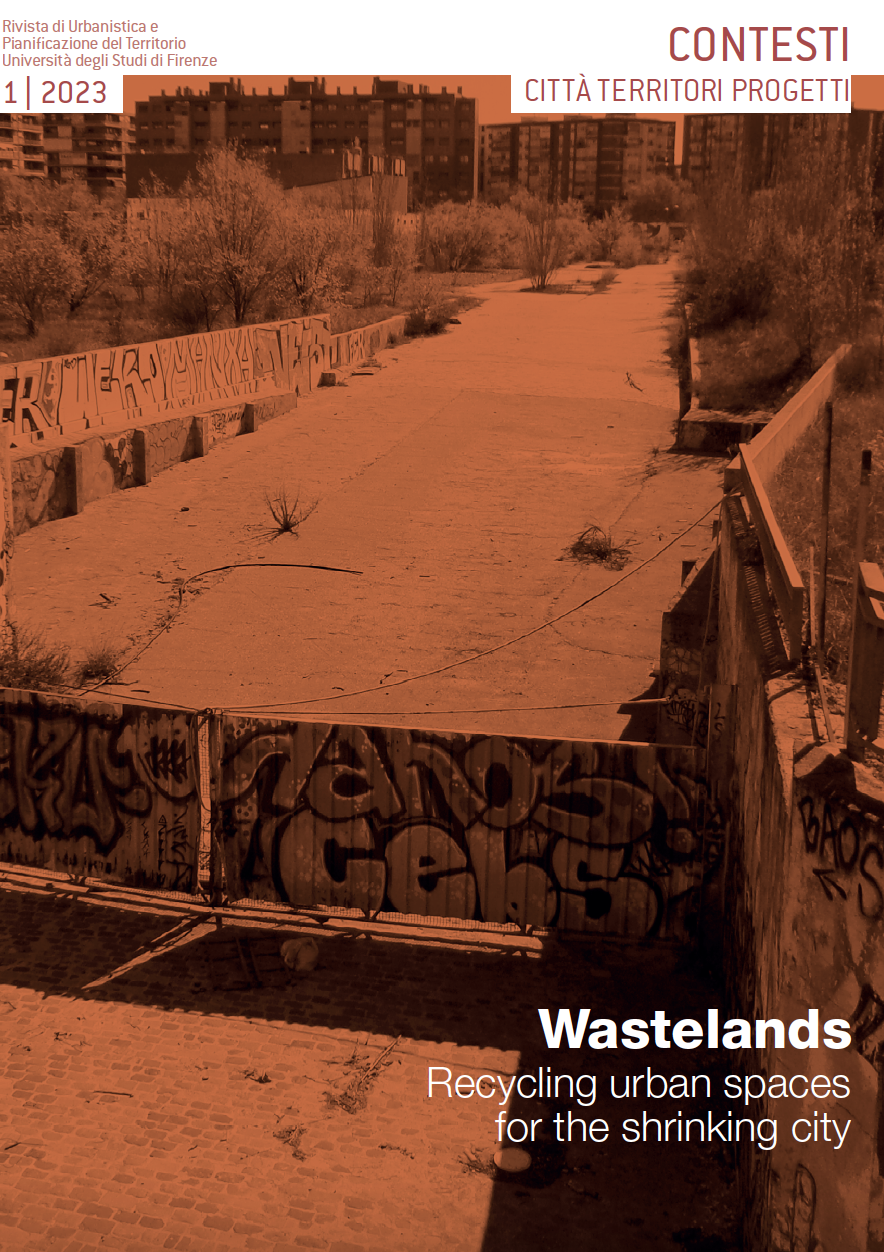Published 2023-09-12
Keywords
- Polycrises,
- Urban regeneration,
- Governance,
- Obsolescence,
- post-institutional properties
How to Cite
Copyright (c) 2023 Federico Camerin, Francesco Gastaldi

This work is licensed under a Creative Commons Attribution-NonCommercial 4.0 International License.
Abstract
Shrinkage processes are multidimensional phenomena affecting city sectors or regions that are experiencing a decline in their economic and social foundations and struggle in finding sound postindustrial revitalisation strategies. The symptoms of such structural crisis are population loss and ageing, economic recession, employment decline and social problems. The repeated international crises that followed the global economic, productive and cultural changes since the 1980s have resulted in the formation of neglected, underused and decay urban voids. The current abandonment scenario and related transformation opportunities are extremely complex and include a wide variety of typologically different wastelands. They comprise shrinking urban and peripheral fabrics, specific empty or obsolete infrastructure, derelict sites, and voids of with heritage value no longer animated by the socio-cultural “regime” that originated them. Wastelands are not unusual in Western society but their pervasiveness is certainly unprecedented given the general socioeconomic crises and dynamics. Abandonment is a challenging and constant process of space production to be filled with new functions by civil society. The re-cycle is even more challenging because the disposal of significant assets has occurred within a limited time frame compared to the post-industrial wastelands. Wastelands constitute a resource with relevant strategic opportunities for addressing a variety of issues – i.e., reducing land consumption, providing urban maintenance and rehabilitation, and increasing the supply of public open spaces, environmental quality characteristics, community standards and services. Last but not least, wastelands may provide new habitable and accessible spaces in contrast to various types of emergencies or polycrises the society is facing – i.e. climate, pandemics, territorial imbalances, ecological and energy resources impoverishment – thus addressing the transition scenario.
Downloads
References
- Berglund L. 2020, Critiques of the shrinking cities literature from an urban political economy framework, «Journal of Planning Literature, vol. 35, n. 4, pp. 423-439
- Bernt M. 2016, The Limits of Shrinkage: Conceptual Pitfalls and Alternatives in the Discussion of Urban Population Loss.” «International Journal of Urban and Regional Research», vol. 40, n. 2, pp. 441-450.
- Camerin F. 2021, Regenerating Former Military Sites in Italy. The Dichotomy between ‘Profit-Driven Spaces’ and ‘Urban Commons, «Global Jurist», vol. 21, n. 3, pp. 497-523
- Carter D. K. (ed) 2016, Remaking Post-Industrial Cities Lessons from North America and Europe, Routledge, Oxon-New York
- Cortese C., Haase A., Grossmann K., Ticha I. 2014, Governing Social cohesion in shrinking cities: The cases of Ostrava, Genoa and Leipzig. «European Planning Studies», vol. 22, n. 10, pp. 2050-2066
- Costa A., Gastaldi F. 2011, Trasformazione e riqualificazione di tessuti di piccola e media impresa: temi e strumenti per la gestione, in M. Zazzi (ed), Parma. I luoghi del lavoro. Analisi e scenari per una riqualificazione urbanistica nella città di Parma, Monte Università Parma Editore, Parma, pp. 178-187
- European Commission 2020, New Leipzig Charter-The transformative power of cities for the common good, <https://ec.europa.eu/regional_policy/en/information/publications/brochures/2020/new-leipzig-charter-the-transformative-power-of-cities-for-the-common-good> (07/23)
- European Commission 2022, The future of cities series. Shrinking cities, <https://www.citiesforum2023.eu/docs/Urban/Shrinking%20Cities.pdf> (07/23)
- Florida R., Rodríguez-Pose A., Storper M. 2023, Critical Commentary: Cities in a post-COVID world, «Urban Studies», vol. 60, n. 8, pp. 1509-1531
- Fol S. 2012, Urban Shrinkage and socio-spatial disparities: Are the remedies worse than the disease?, «Built Environment», vol. 38, n. 2, pp. 259-275
- Gastaldi F., Camerin F. 2022, Brownfield infrastructures, In M. Finger, N. Yanar (eds.), The Elgar Companion to Urban Infrastructure Governance Innovation, Concepts and Cases, Edward Elgar Publishing, Cheltenham, pp. 165-180
- Hirt S., Beauregard R. 2019, Must shrinking cities be distressed cities? A historical and conceptual critique, «International Planning Studies», vol. 75, n. 911, pp. 1-13.
- Hollander J.B., Németh J. 2011, The bounds of smart decline: a foundational theory for planning shrinking cities, «Housing Policy Debate», vol. 21, n. 3, pp. 349-367.
- Hyötyläinen M., Beauregard R. (eds) 2023, The Political Economy of Land Rent, Financialization and Resistance, Routledge, Oxon-New York
- Lopez-Pineiro S. 2020, A Glossary of Urban Voids, Jovis, Berlino
- Pallagst K., Fleschurz R., Nothof S., Uemura T. 2021, Shrinking cities: implications for planning cultures?, «Urban Studies», vol. 58, n. 1, pp. 164-181
- Mallach A. 2023, Smaller Cities in a Shrinking World. Learning to Thrive Without Growth, Island Press, Washington
- Martinez-Fernandez, C., Weyman T., Fol S., Audirac I., Cunningham-Sabot E., Wiechmann T., Yahagi H. 2015, Shrinking cities in Australia, Japan, Europe and the USA: From a global process to local policy responses, «Progress in Planning», vol. 105, pp. 1-48
- Pallagst K., Fleschurz R., Hammer P. (eds) 2022, Reviving shrinking cities. Innovative paths and perspectives towards liveability for shrinking cities. RE-CITY ITN Final Conference 17-18 March 2022, TU Kaiserslautern, Kaiserslautern, <https://rptu.de/fileadmin/re-city/Final_Conference_Dateien/070322_RE-City-Final_Conference_Brochure_MD2.pd> (07/23)
- Partnership on Circular Economy and Sustainable Land Use 2019, Sustainable and Circular re-use of spaces and buildings – Handbook, <https://ec.europa.eu/futurium/en/circular-economy/handbook-sustainable-and-circular-re-use-spaces-and-buildings.html> (07/23)
- Rastrollo Suárez J. J (ed) 2023, Cities and Communities across Europe: governance design for a sustainable future, Aranzadi, Madrid
- Tooze, A. 2022, Welcome to the world of the polycrisis, «Financial Times», <https://www.ft.com/content/498398e7-11b1-494b-9cd3-6d669dc3de33> (07/23)
- Thayer R. L. 2008, The Word Shrinks, the World Expands: Information, Energy and Relocalization, «Landscape Journal», vol. 27, n. 1, pp. 9-22.
- Wiechmann T., Pallagst K. 2012, Urban shrinkage in Germany and the USA: A Comparison of Transformation Patterns and Local Strategies, «International Journal of Urban and Regional Research», vol. 36, n. 2, pp. 261-280
- Wolff M., Mykhnenko V. 2023, COVID-19 as a game-changer? The impact of the pandemic on urban trajectories, «Cities», vol. 134, n. 104162
- Wu C.T., Gunko M., Stryjakiewicz T., Zhou K. (eds) 2022, Postsocialist Shrinking Cities, Routledge, Oxon-New York


